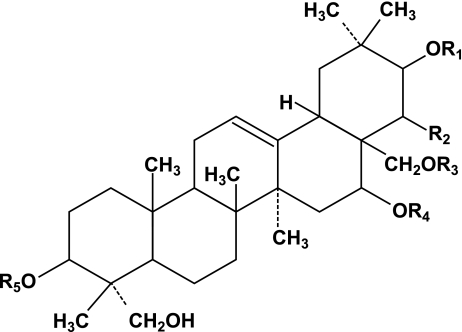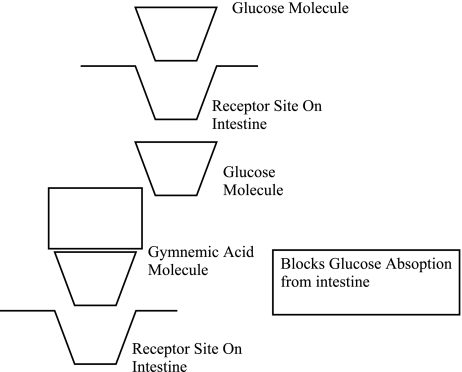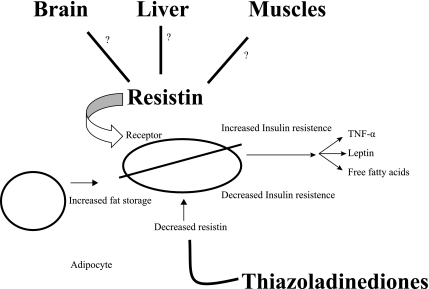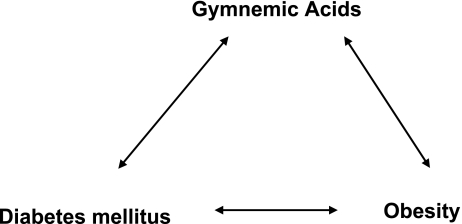Abstract
Gymnema sylvestre is regarded as one of the plants with potent anti diabetic properties. This plant is also used for controlling obesity in the form of Gymnema tea. The active compound of the plant is a group of acids termed as gymnemic acids. It has been observed that there could be a possible link between obesity, Gymnemic acids and diabetes. This review will try to put forth an overall idea about the plant as well as present a molecular perspective linking the common medicine to the most common metabolic disorders.
Keywords: Gymnema sylvestre, antidiabetic, obesity, Gymnemic acids, herbal drug
Introduction
Gymnema sylvestre (G. sylvestre) R. Br.
The plant is native to central and western India, tropical Africa and Australia.
Other names [1], Sanskrit: Meshashringi, madhunashini, Hindi: Gur-mar, merasingi, Marathi: Kavali, kalikardori, vakundi, Gujrathi: Dhuleti, mardashingi, Telugu: Podapatri, Tamil: Adigam, cherukurinja, Kannada: Sannagerasehambu
Plant description
G. sylvestre (Asclepiadaceae), a vulnerable species is a slow growing, perennial, medicinal woody climber found in central and peninsular India. Fig. 1 shows a 5-year old parent plant. It is a potent antidiabetic plant and used in folk, ayurvedic and homeopathic systems of medicine. It is also used in the treatment of asthma, eye complaints, inflammations, family planning and snakebite. In addition, it possesses antimicrobial, antihypercholesterolemic, hepatoprotective and sweet suppressing activities. It also acts as feeding deterrents to caterpillar, Prodenia eridania; prevent dental caries caused by Streptococcus mutans and in skin cosmetics [2].
Fig. 1.

G. sylvestre parent plant (Courtesy: Laila Impex, Hyderabad, India. 2005).
G. sylvestre is a large, more or less pubescent, woody climber. It is occasionally cultivated as medicinal plant. Leaves are opposite, usually elliptic or ovate (1.25–2.0 inch × 0.5–1.25 inch). Flowers are small, yellow, in umbellate cymes. Follicles are terete, lanceolate, upto 3 inches in length.
Phytochemistry of G. sylvestre
G. sylvestre leaves contain triterpene saponins belonging to oleanane and dammarene classes. Oleanane saponins are gymnemic acids and gymnemasaponins, while dammarene saponins are gymnemasides. Besides this, other plant constituents are flavones, anthraquinones, hentri-acontane, pentatriacontane, α and β-chlorophylls, phytin, resins, d-quercitol, tartaric acid, formic acid, butyric acid, lupeol, β-amyrin related glycosides and stigmasterol. The plant extract also tests positive for alkaloids. Leaves of this species yield acidic glycosides and anthroquinones and their derivatives [3].
Gymnemic acids have antidiabetic, antisweetener and anti-inflammatory activities. The antidiabetic array of molecules has been identified as a group of closely related gymnemic acids after it was successfully isolated and purified from the leaves of G. sylvestre [4, 5]. Later, the phytoconstituents of G. sylvestre were isolated, and their chemistry and structures were studied and elucidated [6–9].
Mechanism of Action of Gymnemic Acids
Gymnemic acid formulations have also been found useful against obesity, according to recent reports [10]. This is attributed to the ability of gymnemic acids to delay the glucose absorption in the blood. The atomic arrangement of gymnemic acid molecules is similar to that of glucose molecules. These molecules fill the receptor locations on the taste buds thereby preventing its activation by sugar molecules present in the food, thereby curbing the sugar craving. Similarly, Gymnemic acid molecules fill the receptor location in the absorptive external layers of the intestine thereby preventing the sugar molecules absorption by the intestine, which results in low blood sugar level [11].
G. sylvestre leaves have been found to cause hypoglycemia in laboratory animals and have found a use in herbal medicine to help treat adult onset diabetes mellitus (NIDDM). When Gymnema leaf extract is administered to a diabetic patient, there is stimulation of the pancreas by virtue of which there is an increase in insulin release [12]. These compounds have also been found to increase fecal excretion of cholesterol [13], but further studies to prove clinical significance in treating hypercholesterolemia (high serum cholesterol) are required. Other uses for Gymnema leaf extract are its ability to act as a laxative, diuretic, and cough suppressant. These other actions would be considered adverse reactions when Gymnema is used for its glucose lowering effect in diabetes.
Gymnema leaf extract, notably the peptide ‘Gurmarin’, has been found to interfere with the ability of the taste buds on the tongue to taste sweet and bitter. Gymnemic acid has a similar effect. It is believed that by inhibiting the sweet taste sensation, people taking it will limit their intake of sweet foods, and this activity may be partially responsible for its hypoglycemic effect [14].
There are some possible mechanisms by which the leaves and especially Gymnemic acids from G. sylvestre exert its hypoglycemic effects are: 1) it increases secretion of insulin, 2) it promotes regeneration of islet cells, 3) it increases utilization of glucose: it is shown to increase the activities of enzymes responsible for utilization of glucose by insulin-dependant pathways, an increase in phosphorylase activity, decrease in gluconeogenic enzymes and sorbitol dehydrogenase, and 4) it causes inhibition of glucose absorption from intestine.
The gymnemic acid components are believed to block the absorption of glucose in the small intestine, the exact action being unknown. It could be involve one or more mechanisms [14].
One of the mechanisms responsible for adult onset diabetes mellitus is a form of insulin resistance, which is attributed to the inability of insulin to enter cells via the insulin receptor. Gymnema may overcome this resistance, but require further studies to confirm its validity and also whether the effect is clinically relevant. Should this effect be proven, Gymnema may prove useful in both adult onset (NIDDM) and juvenile onset diabetes mellitus (IDDM) to help insulin enter cells. In the case of IDDM, the insulin is injected by syringe and is not secreted from the pancreas [15].
The leaves are also noted for lowering serum cholesterol and triglycerides. The primary chemical constituents of Gymnema include gymnemic acid, tartaric acid, gurmarin, calcium oxalate, glucose, stigmasterol, betaine, and choline. While the water-soluble acidic fractions reportedly provide the hypoglycemic action, it is not yet clear what specific constituent in the leaves is responsible for the same. Some researchers have suggested gymnemic acid as one possible candidate, although further research is needed [16]. Both gurmarin (another constituent of the leaves) and gymnemic acid have been shown to block sweet taste in humans. The major constituents of the plant material 3B glucuronides of different acetylated gymnemagenins, gymnemic acid a complex mixture of at least 9 closely related acidic glucosides [17–19].
The following figure could provide a diagrammatic representation for explaining the action of gymnemic acids on the intestinal receptors. The basic function of the acids is to bind to the receptor on the intestine, and stop the glucose molecule from binding to the receptor. Thus, gymnemic acids prevent the absorption of excess glucose.
Diabetes Mellitus
Diabetes mellitus can be defined as a group of syndromes characterized by hyperglycemia, altered metabolism of lipids, carbohydrates and proteins along with an increased risk of complications from vascular disease. It is characterized by polydipsia (chronic excessive thirst and fluid intake), polyphagia excessive eating), glycosuria (excessive glucose in the blood) and “acetone breath” i.e. the breath of the patient smells of acetone due to an abnormal increase of ketone bodies in the blood. The classification of diabetes can be done in two types as: Type-1 (insulin-dependent diabetes mellitus, IDDM) and Type-2 (non-insulin-dependent diabetes mellitus, NIDDM) [20, 21].
Herbal medicines for treatment of diabetes
The Indian subcontinent has given to the medicinal world, natural remedies such as Ayurveda, Yunani and Siddha. Based on such systems, we can find not only new remedies; but also new lead molecules may be obtained. Though data from clinical trials are positive, further investigations coupled with extensive clinical trials are required. Most of the drugs from plant sources are secondary metabolites, which have no role in plant metabolism; but are postulated to play a significant role in the plant defense mechanism. However, not much difference is seen in the basic metabolic processes in plants as well as animals [21].
One of the alternative medicines to both diabetes and obesity could be G. sylvestre plant preparation, as it known to have a good effect for curbing of diabetes by blocking sugar binding sites and hence not allowing the sugar molecules to accumulate in the body.
Obesity and Its Impact on the Human Body
Obesity, technically, is characterized by the increased storage of tri glycerides (fat molecules) in the adipose tissue thereby causing insulin resistance. It could also be defined as the condition of a human being in which the body contains more fat than required and which can lead to a diseased state. Obesity is usually caused by an abnormality of feeding regulatory mechanism. This can result from either psychogenic factors that affect this regulation or actual abnormalities of regulatory system in hypothalamus. But in many cases no specific cause can be identified. Contributing factors include genetic factors, eating habits childhood over nutrition and social customs, among many others. Obesity also plays an important role in the development of diabetes. It decreases the number of insulin receptors in insulin target cells throughout the body, thus making the amount of insulin that is available, less effective in promoting its usual metabolic effects [22].
Exploring the link between obesity and diabetes
It is a well-known fact that molecular mechanisms underlying the link between obesity and diabetes have been elusive, but new research studies show that there could be a enzymatic link between the two most common metabolic disorders [23]. Initially, the trend towards the link was the presence of free fatty at higher levels in obese people than in non-obese people [24]. In 2001, there were reports of a missing link in the form of some chemical substance that proves the inability of the body insulin to control blood sugar levels.
Claire (2001) in his recent research studies suggested a new theory. It is a well-known fact that type II diabetes is the most common form of disease and when the insulin of the body loses its ability for glucose uptake, the diseased condition of the body gives way to obesity. Also, it was reported that nearly 80% of the diabetes patients are obese. The fat cells of the body were shown to produce a hormone called resistin (resisting of insulin) The energy from stored fat is transported in the body in the form of fatty acids by virtue of which the their levels increase in the body, thus causing an important factor in insulin resistance built up throughout the body. This hormone impairs insulin action and causes intolerance to glucose or blood sugar.
The following diagram would explain the relation of resistin to other parts of the body that are involved in diabetes and obesity. Thus, the newly discovered protein, resistin, could be an underlying the link between obesity and diabetes. Research scientists all over the word started studying the molecular mechanisms that lead to linkages between obesity and diabetes [23].
Hypothesis
Linkage between obesity, diabetes, Gymnemic acids: a possible linkage
From the above aspects of the diseases i.e. obesity, diabetes mellitus and gymnemic acids, a linkage amongst them is quite clear. The diagrammatic representation shown below will give an idea as to how the three are inter-linked.
Hence, it is obvious that same medicine can be used for curbing of both the diseases. Obesity is the main consequence from the accumulation of the carbohydrates and fats. Gymnemic acids curb the binding of carbohydrates to the receptors in the intestine and hence, the “empty calories” are taken care of so that the body does not go into obese stage. The acids are also useful in curbing of diabetes by a similar mechanism as mentioned above for carbohydrates.
Currently, gymnemic acids are being sold in the form of Gymnema Tea, for curbing obesity. In Japan, there are teas being made from G. sylvestre leaves and are being promoted as a natural method for controlling obesity and diabetes [14].
In 1997, a Japanese Scientist described the anti-sweet activity of gymnemic acid, the inhibition of intestinal sugar absorption and insulin secretion by gymnemic acids, anti-diabetic effect of leaves of G. sylvestre and the development of Gymnema tea and Gymnema chewing gum for health food for preventing obesity and diabetes.
Conclusions
Although there are many phytoconstituents that could combat diabetes and obesity, a single phytoconstituent that could be used in the treatment of both the diseases simultaneously would be a welcome addition. Gymnemic acid fulfills this criterion. The common masses do not avail of the fact that obesity can also be caused due to over-accumulation of sugar molecules specially sucrose, along with fat molecules. The common man layman needs to be made aware of these facts, since they are posing a big threat after cardiac problems and cancer. This review paper aimed at putting forth a molecular perspective of the medicinal aspect of gymnemic acids, and also a possible linkage between obesity and diabetes via a potential common medicine.
Fig. 2.
Basic molecular structure of Gymnemic acid [8]
Fig. 3.
Schematic representation of competitive inhibition of receptor site on intestine by Gymnemic acid [12]
Fig. 4.
Resistin and its areas of linkage [23]
Fig. 5.
Linkage between obesity, diabetes mellitus and Gymnemic acids [12]
References
- 1.The Wealth of India. Raw materials, vol. IV. Council of Scientific and Industrial Research; New Delhi: 1956. A Dictionary of Indian Raw materials and Industrial products; pp. 276–277. [Google Scholar]
- 2.Komalavalli N., Rao M.V. In vitro micropropagation of Gymnema sylvestre: multipurpose medicinal plant. Plant Cell, Tissue and Organ Culture. 2000;61:97–105. [Google Scholar]
- 3.Dateo G.P., Long L. Gymnemic acid, the antisaccharine principle of Gymnema sylvestre. Studies on isolation and heterogenesity of gymnemic acid A1. J. Agric. Food Chem. 1973;21:899–903. doi: 10.1021/jf60189a030. [DOI] [PubMed] [Google Scholar]
- 4.Liu H.M., Kiuchi F., Tsuda Y. Isolation and structure elucidation of Gymnemic acids, antisweet principles of Gymnema sylvestre. Chem. Pharm. Bull. 1992;40:1366–1375. doi: 10.1248/cpb.40.1366. [DOI] [PubMed] [Google Scholar]
- 5.Sinsheimer J.E., Manni P.E. Constituents from Gymnema sylvestre leaves. J. Pharm. Sci. 1965;54:1541–1544. doi: 10.1002/jps.2600541035. [DOI] [PubMed] [Google Scholar]
- 6.Sinsheimer J.E., Subbarao G. Constituents from Gymnema sylvestre leaves VIII: Isolation, chemistry and derivatives of gymnemagenin and gymnestrogenin. J. Pharm. Sci. 1971;60:190–193. doi: 10.1002/jps.2600600205. [DOI] [PubMed] [Google Scholar]
- 7.Sinsheimer J.E., Subba R.G., Mc Ilhenny H.M. Constituents from Gymnema sylvestre Leaves V: Isolation and preliminary characterization of Gymnemic acids. J. Pharm. Sci. 1970;59:622–628. doi: 10.1002/jps.2600590510. [DOI] [PubMed] [Google Scholar]
- 8.Yoshikawa K., Amimoto K., Arihara S., Matsuura K. Structure studies of new antisweet constituents from Gymnema sylvestre. Tetr. Lett. 1989;30:1103–1106. [Google Scholar]
- 9.Yoshikawa K., Nakagawa M., Yamamoto R., Arihara S., Matsuura K. Antisweet natural products V structures of gymnemic acids VIII-XII from Gymnema sylvestre R. Br. Chem. Pharm. Bull. 1992;40:1779–1782. [Google Scholar]
- 10.Yoshikawa K., Kondo Y., Arihara S., Matsuura K. Antisweet natural products IX structures of gymnemic acids XV-XVIII from Gymnema sylvestre R. Br. Chem. Pharm. Bull. 1993;41:1730–1732. [Google Scholar]
- 11.Sahu N., Mahato S.B., Sarkar S.K., Poddar G. Triterpenoid Saponins from Gymnema sylvestre. Phytochem. 1996;41:1181–1185. doi: 10.1016/0031-9422(95)00782-2. [DOI] [PubMed] [Google Scholar]
- 12.Kanetkar P.V., Laddha K.S., Kamat M.Y. Poster presented at the 16th ICFOST meet organized by CFTRI and DFRL. Mysore, India: 2004. Gymnemic acids: A molecular perspective of its action on carbohydrate metabolism. [Google Scholar]
- 13.Persaud S.J., Al-Majed H., Raman A., Jones P.M. Gymnema sylvestre stimulates insulin release in vitro by increased membrane permeability. J. Endocrinol. 1999;163:207–212. doi: 10.1677/joe.0.1630207. [DOI] [PubMed] [Google Scholar]
- 14.Nakamura Y., Tsumura Y., Tonogai Y., Shibata T. Fecal steroid excretion is increased in rats by oral administration of gymnemic acids contained in Gymnema sylvestre leaves. J. Nutr. 1999; 129:1214–1222. doi: 10.1093/jn/129.6.1214. [DOI] [PubMed] [Google Scholar]
- 15.Agarwal S.K., Singh S.S., Verma S., Lakshmi V., Sharma A. Chemistry and medicinal uses of Gymnema sylvestre (gur-mar) Leaves: A Review. Indian Drugs. 2000;37:354–360. [Google Scholar]
- 16.Khare A.K., Tondon R.N., Tewari J.P. Hypoglycemic activity of an indigenous drug Gymnema sylvestre in normal and diabetic persons. Ind. J. Physiol. Pharmacol. 1983;27:257–261. [PubMed] [Google Scholar]
- 17.Maeda M., Iwashita T., Kurihara Y. Studies on taste modifiers II: Purification and structure determination of gymnemic acids, antisweet active principle from Gymnema sylvestre leaves. Tetr. Lett. 1989;30:1547–1550. [Google Scholar]
- 18.Manni P.E., Sinsheimer J.E. Constituents from Gymnema sylvestre leaves. J. Pharm. Sci. 1965;54:1541–1544. doi: 10.1002/jps.2600541035. [DOI] [PubMed] [Google Scholar]
- 19.Sinsheimer J.E., Subbarao G. Constituents from Gymnema sylvestre leaves VIII: Isolation, chemistry and derivatives of gymnemagenin and gymnestrogenin. J. Pharm. Sci. 1971;60:190–193. doi: 10.1002/jps.2600600205. [DOI] [PubMed] [Google Scholar]
- 20.Dahanukar S.A., Kulkarni R.A., Rege N.N. Pharmacology of medicinal plants and natural products. Indian J. Pharmacol. 2000;32:S81–S118. [Google Scholar]
- 21.Ramachandran A., Snehalatha C., Satvavani K., Sivasankari S., Vijav V. Type 2 diabetes in Asian-Indian urban children. Diabetes Care. 2003;26:1022–1025. doi: 10.2337/diacare.26.4.1022. [DOI] [PubMed] [Google Scholar]
- 22.Jachak S.M. Herbal drugs as antidiabetic: an overview. CRIPS. 2002;3:9–13. [Google Scholar]
- 23.Flier J.S. Prevention of obesity reduces the risk of a wide range of health problems. The missing link with obesity? Nature. 2001;409:292–293. doi: 10.1038/35053251. [DOI] [PubMed] [Google Scholar]
- 24.Claire S. The hormone resistin links obesity to diabetes. Nature. 2001:307. doi: 10.1038/35053000. [DOI] [PubMed] [Google Scholar]






